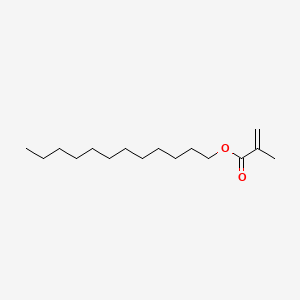








1. Dma, Methacrylate
2. Lauryl Methacrylate
1. 142-90-5
2. Lauryl Methacrylate
3. Dodecyl 2-methylacrylate
4. 2-propenoic Acid, 2-methyl-, Dodecyl Ester
5. N-dodecyl Methacrylate
6. Metazene
7. Dodecyl 2-methylprop-2-enoate
8. Dodecyl 2-methyl-2-propenoate
9. Methacrylic Acid, Dodecyl Ester
10. Sipomer Lma
11. Lama
12. Ageflex Fm 246
13. Methacrylic Acid, Lauryl Ester
14. Ge 410 (methacrylate)
15. Laurylester Kyseliny Methakrylove
16. Laurylmethacrylate
17. Nsc 5188
18. Ge 410
19. Sr 313
20. N-lauryl Methacrylate
21. Acrylic Acid, 2-methyl-, Dodecyl Ester
22. B6l83074bz
23. Nsc-5188
24. Dodecyl Methacrylate (stabilized With Mehq)
25. Dsstox_cid_7103
26. Dsstox_rid_78311
27. Dsstox_gsid_27103
28. Caswell No. 521
29. Dodecyl-2-methylacrylate
30. Cas-142-90-5
31. Hsdb 5417
32. Einecs 205-570-6
33. Epa Pesticide Chemical Code 053101
34. Brn 1708160
35. Laurylester Kyseliny Methakrylove [czech]
36. Unii-b6l83074bz
37. Ai3-08765
38. Ageflex Fm-12
39. 1-dodecyl Methacrylate
40. Methacrylic Acid Dodecyl
41. 2-methyl-2-propenoic Acid, Dodecyl Ester
42. 1-dodecanol Methacrylate
43. Ec 205-570-6
44. Dodecyl 2-methylacrylate #
45. Schembl14995
46. Wln: 12ovyu1
47. Methacrylic Acid Lauryl Ester
48. Methacrylic Acid Dodecyl Ester
49. Chembl1903701
50. Dtxsid4027103
51. Nsc5188
52. Lauryl Methacrylate [inci]
53. Tox21_201903
54. Tox21_303316
55. Mfcd00008972
56. Zinc38141474
57. N-dodecyl Methacrylate [hsdb]
58. Akos015903634
59. Cs-w012588
60. Methyl-2-propenoic Acid, Dodecyl Ester
61. Lauryl Methacrylate(5cp(25 Degrees C))
62. Ncgc00164408-01
63. Ncgc00164408-02
64. Ncgc00257059-01
65. Ncgc00259452-01
66. 170292-57-6
67. As-76599
68. Propenoic Acid, 2-methyl-, Dodecyl Ester
69. Db-042652
70. Dodecyl Ester Of 2-methyl-2-propenoic Acid
71. Ft-0625575
72. M0083
73. Dodecyl Methacrylate, (stabilized With Mehq)
74. Lauryl Methacrylate, Purum, >=95.0% (gc)
75. E75856
76. A807982
77. J-007716
78. Q3395664
79. Lauryl Methacrylate, Contains 500 Ppm Mehq As Inhibitor, 96%
| Molecular Weight | 254.41 g/mol |
|---|---|
| Molecular Formula | C16H30O2 |
| XLogP3 | 7.2 |
| Hydrogen Bond Donor Count | 0 |
| Hydrogen Bond Acceptor Count | 2 |
| Rotatable Bond Count | 13 |
| Exact Mass | 254.224580195 g/mol |
| Monoisotopic Mass | 254.224580195 g/mol |
| Topological Polar Surface Area | 26.3 Ų |
| Heavy Atom Count | 18 |
| Formal Charge | 0 |
| Complexity | 221 |
| Isotope Atom Count | 0 |
| Defined Atom Stereocenter Count | 0 |
| Undefined Atom Stereocenter Count | 0 |
| Defined Bond Stereocenter Count | 0 |
| Undefined Bond Stereocenter Count | 0 |
| Covalently Bonded Unit Count | 1 |
Small quantities of methacrylates may readily be metabolized by saponification into the alcohol and methacrylic acid. The latter may form an acetyl-coenzyme A derivative, which then enters the normal lipid metabolism. /Methacrylates/
Clayton, G. D. and F. E. Clayton (eds.). Patty's Industrial Hygiene and Toxicology: Volume 2A, 2B, 2C: Toxicology. 3rd ed. New York: John Wiley Sons, 1981-1982., p. 2298
Acrylates and methacrylates are detoxified predominantly via conjugation with glutathione via the Michael addition reaction or glutathione-S-transferase. They are also likely to be hydrolyzed via carboxylesterases. The lower molecular weight esters are rapidly metabolized and eliminated, therefore, will not likely cause cumulative toxicity. /Methacrylates/
Bingham, E.; Cohrssen, B.; Powell, C.H.; Patty's Toxicology Volumes 1-9 5th ed. John Wiley & Sons. New York, N.Y. (2001)., p. V6 600
